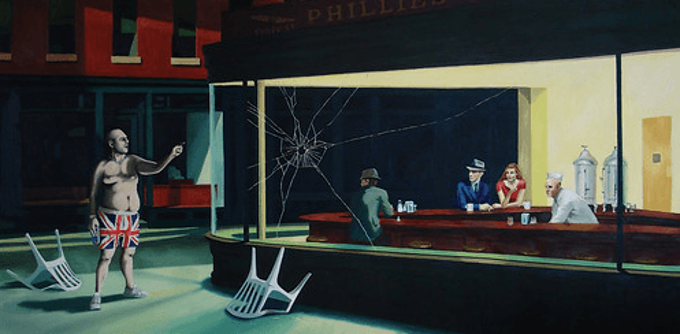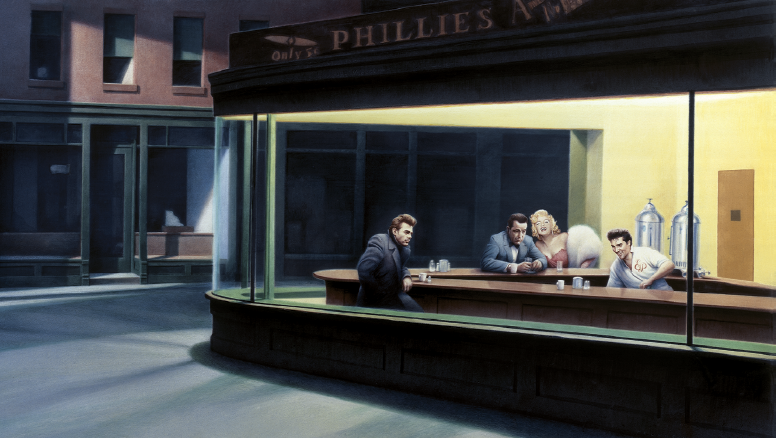In your own lifetime, you might have noticed the streets you walk down every day changing. New convenience stores pop up; old homes are torn down; restaurants come and go. Historians looking to reconstruct a cityscape from decades or even centuries ago need as much data as possible about what it looked like then. Consider the following photographic records of past cityscapes, then discuss: would they be enough to reconstruct the world as it existed when they were taken? What advice would you give to someone trying to photograph the world we live in today for future reconstruction?
Ed Ruscha | Sunset Boulevard
- "12 Sunsets" is an interactive website launched by the Getty Research Institute that allows users to explore photographs of the Sunset Strip, a 2 1/2 mile stretch of Sunset Boulevard in Los Angeles, taken by artist Ed Ruscha over 40 years. In 1966, Ruscha mounted a camera in the back of a truck and captured thousands of frames while driving slowly and displaying a sign that read "Please Pass." This project has been well-received in the art community as a unique and captivating online experience. Here is the link to the interactive site of the website, I recommend you try it out! (the timeguessr nerd in me is excited)
This is one of the million frames captured for the 12 sunsets project.
This is one of the million frames captured for the 12 sunsets project.
Sébah & Joaillier | Ottoman Panorama

William M. McCarthy | Pre-1906 San Francisco
- The California State Archives recently made thousands of images from the collection of photographers Grayce and William M McCarthy available online. These photographs provide a unique and detailed glimpse into 20th century life in Northern California. Secretary of State Alex Padilla expressed excitement over this addition to the state's online database, stating that the McCarthy's were pioneers of automobile travel and personal photography. Of particular interest to San Franciscans are the rare photos taken just days before the devastating 1906 earthquake. This is a valuable resource for understanding the city's history and growth.
:format(webp):no_upscale()/cdn.vox-cdn.com/uploads/chorus_asset/file/9907777/1906_6.jpg)
“Market St. San Francisco -- 1906. Street scene of Market Street in San Francisco before the earthquake and fire of April 1906.” This is one of the several images in the article.
Images of the Late Qing Dynasty
- The arrival of photography in China in the mid-19th century was significant for capturing a way of life that would soon disappear with the fall of the Qing Dynasty. As China was beginning to modernize and transition from its old ways, photography preserved the image of the late Qing period. Currently on display in New York City as part of Asia Week New York is an exhibition of rare photographs from the Stephan Loewentheil Historical Photography of China Collection, showcasing the country's history and evolution through the lens of photography.
Images of Meiji-Era Japan
- The history of photography in Japan dates back to the Edo period when the medium was introduced by Dutch merchants living on Dejima Island in Nagasaki Bay. The early photographers in Japan traveled to Nagasaki to learn the process, with the first successful photograph being taken in 1857 by two Japanese photographers. The early technique, called daguerreotype, was fragile and produced a single image on a copper plate. However, it was soon replaced by the wet collodion method which allowed for multiple prints to be made. By the Meiji period, photography had become a thriving commercial industry in Japan. In the late 19th century, the Meiji government in Japan loosened travel restrictions for foreigners, leading to an influx of tourists. Photographs soon became popular souvenirs for these travelers, depicting traditional Japanese culture and landscapes. However, many of these images were more of a fantasy than reality, as tourists were more interested in escaping modern industrial society and the changing Japanese culture. These souvenir photographs, known as Yokohama-style photography, were often hand-colored and staged, and could be purchased in albums containing 25 to 100 prints. The subjects were divided into three categories: customs and types, women, and famous places and views. Tourists also had the option to visit a studio and select photos that represented their travel experiences.
Explore the Japanese art of kintsugi—the repair of broken pottery using lacquers that do nothing to conceal the original fractures. Practitioners see an object's breakage and repair as an integral part of the object's history. Discuss with your team: should the principles of kintsugi be applied to other forms of reconstructing the past?
- Kintsugi technique involves repairing broken pottery with a mixture of lacquer and powdered gold, signifying the beauty in imperfection. It aligns with the Japanese philosophy of wabi-sabi, which celebrates the incomplete and simplicity. The process of repairing broken pottery can take up to three months, using the sap of an indigenous tree and gold to highlight the cracks. In a society that values perfection and youth, kintsugi serves as a reminder to embrace flaws and appreciate the beauty in human fragility.

Examples of kintsugi.
Whether we see Edward Hopper's Nighthawks as a testament to solitude or a bittersweet tug toward a lost era of root beer floats, it has provided rich source material for new takes in both academic art and pop culture. Consider the selections below, then discuss: do works such as Nighthawks oversimplify how we see the past? Can images be too iconic?
Nighthawks | Edward Hopper - In an all-night diner, three customers sit at the counter opposite a server, each appear to be lost in thought and disengaged from one another. The composition is tightly organized and spare in details: there is no entrance to the establishment, no debris on the streets. Through harmonious geometric forms and the glow of the diner’s electric lighting, Hopper created a serene, beautiful, yet enigmatic scene. Although inspired by a restaurant Hopper had seen on Greenwich Avenue in New York, the painting is not a realistic transcription of an actual place. As viewers, we are left to wonder about the figures, their relationships, and this imagined world.

Nighthawks by Edward Hopper
Are You Using that Chair | Banksy
- In his version of Nighthawks, the artist depicts a threatening chubby man only wearing Union Jack underwear, pointing angrily at the cracked window of Hopper’s dinner. Two plastic chairs are scattered on the sidewalk around him, and it appears that he likely threw them in an attempt to break the window. This figure potentially represents the angry British working class demanding a seat at the elite’s table.

Boulevard of Broken Dreams | Gottfried Helnwein
- It shows a scene late at night in a diner in the USA during the 1950s. Outside, the street is dark and empty. Inside, there are three people sitting at the counter, two men and a woman, and there’s a barman standing behind the counter. The couple on the right are smartly dressed and the woman is laughing, but the man sitting next to her looks worried and unhappy. The barman is smiling, but the atmosphere of the painting is bleak and lonely.
- The four people in the painting are all famous American stars from the 20th century. The barman is the singer Elvis Presley – ‘the king of rock ’n’ roll’. The man on the left is the actor James Dean. The woman is the film star Marilyn Monroe, and the man in the blue suit is the actor Humphrey Bogart.



:format(webp):no_upscale()/cdn.vox-cdn.com/uploads/chorus_asset/file/9907777/1906_6.jpg)



